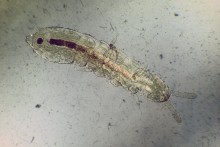I am able to identify Collembola on species level.
Simultaneously with the soil mites Collembola (springtails) belong to the dominant soil arthropods with densities of partly over 100000 ind. /m² in forest soils. The Collembola communities of deciduous forests have high species numbers (often 50 species per site) whereas in agricultural landscapes the species number of Collembola is comparatively low (20-30 species per site). Collembola feed on many different food sources as leaf litter, soil fungi and living and dead plant roots. They play an important role in decomposition processes mainly caused by their selective feeding on soil fungi and bacteria.
Within the Collembola 3 important morphological groups are distinguished due to the different adaptions in their habitat use.


- Euedaphic Collembola are typical soil animals with a short or missing furca. This animals are very small, low pigmented, blind and have short extremities. Typial species are Protaphorura armata (photo) und Mesaphorura sp. (photo)


- Hemiedaphic Collembola live in the litter layer and mostly have a well developed furca, are strongly pigmented and have ocelli. Thus, they have an intermediate position between the euedaphic and the epedahic Collembola (see below). Typical species are Folsomia quadrioculata (photo) und Ceratophysella denitulata (photo).

- Epedaphic Collembola live on the litter and soil surface and in the herb layer of forests and meadows. These animals often have a very long furca,are strongly pigmented (e.g. violett or blue), have long extremities and well developed ocelli. They partly feed on aboveground living plant material (e.g. leaves) and pollen. Typical species are Lepidocyrtus lanuginosus (photo) und Sphyrotheca lubbocki (photo).



